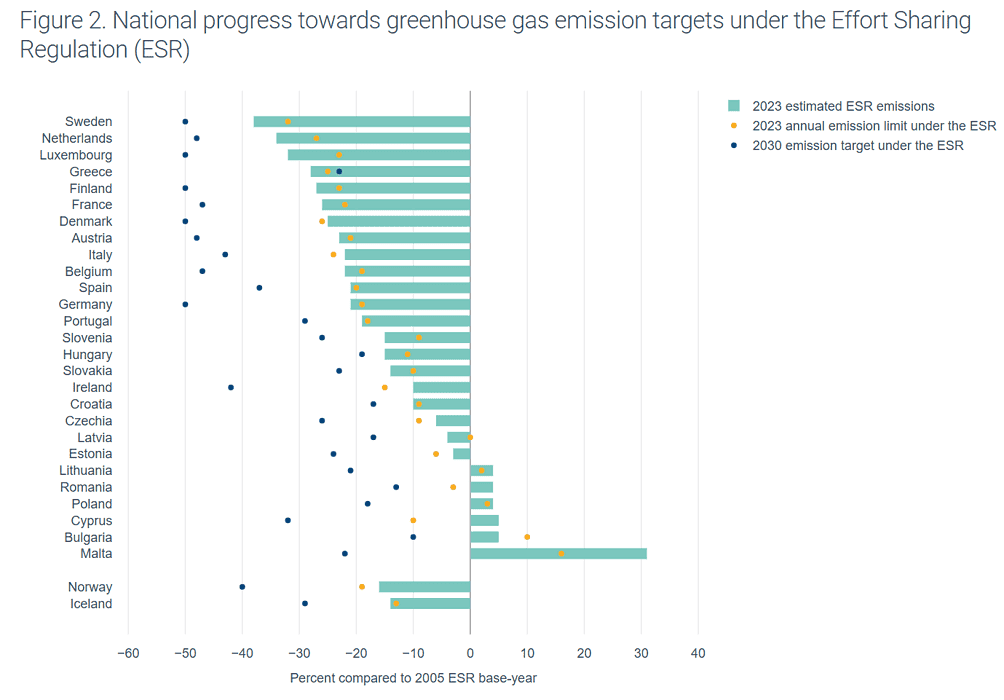Europe's emissions drop, but more ambition is needed
According to a report by the European Environment Agency, emissions decreased by 39% in 2023 compared to 1990. In this episode of Behind the Figures, we examine this data.
Published on November 6, 2024

Mauro swapped Sardinia for Eindhoven and has been an IO+ editor for 3 years. As a GREEN+ expert, he covers the energy transition with data-driven stories.
Baku (Azerbaijan) will host the 29th Convention on Climate Change (COP29) the following week. Among the many talking points will be climate investment to slash emissions. The World Meteorological Organization (WMO) reported last week that greenhouse gas (GHG) atmospheric concentrations surged to a new record high in 2023. Such a climb will result in rising temperatures in the years to come.
As global emissions surge, Europe is on an opposite trend. According to a new report by the European Environment Agency (EEA), in 2023, the EU’s total GHG emissions fell by 37% compared to 1990. The data comes from the latest member states' reports and sources analyzed by the EEA.

About Behind the Figures
In Behind the Figures, we examine one figure in every episode. Using charts and graphs, we break down the figures and provide context to help you make more sense of them.
Although global emissions rose by over 60% during this period, the EU saw decreased GHG outputs. As per the report, three drivers justify this reduction: the cutback on coal usage, the rise of renewable energy, and a drop in energy consumption.
Despite this acceleration, based on current policies, member states would cut their emissions levels by 43% in 2030 as compared to 1990. Adding the currently planned measures, the share would rise to 49%, falling short by 6% of the Fit for 55 targets for GHG emissions reduction.
Decrease in coal usage
According to the report, as the use of energy-related fossil fuels declined, GHG emissions decreased accordingly. The use of coal—and, in general, of all solid fossil fuels—and oil products plummeted since 1990. Specifically, solid fossil fuels saw the steepest drop, with 21.4% of net GHG emissions, followed by a 7.4% decline in oil products-related emissions.
During this period, the surge in the use of natural gas has partially offset these reductions. However, GHG outputs connected to fossil fuels have been constantly decreasing. In addition, emissions related to agriculture mining and waste management activities also dropped.
The EEA paper also notes how forests' net CO2 sequestration rose until 2010, with the annual amount of forest carbon removals declining since then.
Lower energy consumption
The EU’s 2023 GHG emissions figures also show the largest year-on-year reduction (8%) compared to 2022. One of the key messages conveyed by the EEA report is that this cut in emissions happened while stimulating prosperity. As per the report, the decrease is also due to the EU’s commitment to energy efficiency in primary and final energy consumption. Primary energy consumption relates to using energy in its natural forms– think of burning coal to generate electricity. Final energy consumption refers to the energy that reaches its end user– like the electricity you use at home.
The rollout of renewables
Energy supply and industry are the sectors that have reduced their GHG emissions the most in 2023. The surge in the rollout of renewable energy production and the combination of reduced output and efficiency gains in the industrial sector are the reasons behind such decreases. The EEA estimates that 24.1% of the EU’s total energy mix in 2023 came from renewable sources. This marks a one percentage point increase compared to the previous year.
The column chart below shows the trends in renewable energy shares (RESs) across three sectors: electricity, heating and cooling, and transport. The electricity sector is decarbonizing faster and has the largest RES—42.1% in 2023. The heating and cooling sector follows, surpassing the 25% mark. Transport RES passed the 10% mark.
What countries are doing better?
The report also presents national data on emissions change. Since 2005, Sweden and the Netherlands have curbed their GHG emissions the most—by 37% and 34%, respectively. Under the Effort Sharing Regulation (ESR), Stockholm pledged to reduce its GHG outputs by half compared to 2005 levels, as did Germany, Finland, Luxembourg, and Denmark.

Sweden, Finland, and Latvia were the EU countries with the largest share of renewable energy in 2023. By contrast, Luxembourg and Belgium had 12% and 14% of their energy consumption covered by renewables, respectively. The Netherlands falls way behind the European average of 24.1% with 15.7%.
What is missing?
Since current and planned policy measures will accelerate but will not suffice to cut emissions by 55% in 2030, the EEA underlines how the ongoing cycle of updates to national energy and climate plans (NECPs) is a chance to implement additional measures. The European Commission's initial assessment of the draft plans confirms increased collective ambitions.
At the same time, the EU’s Energy Directive prescribes a minimum share of renewable energy for 2030 of 42.5%—with the aim of achieving 45%. However, as shown in the graph above, renewables deployment is uneven across the member states. At current rates, as per the EU Commission assessment of NECPs, RES in final energy consumption could reach between 38.6% and 39.3% in 2030. More ambition is needed to comply with the EU binding targets.
